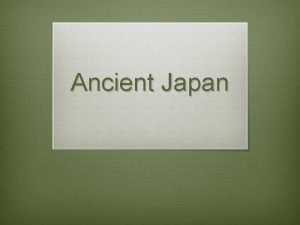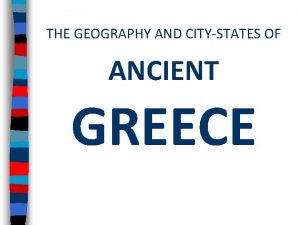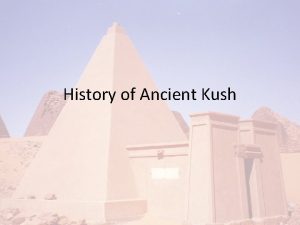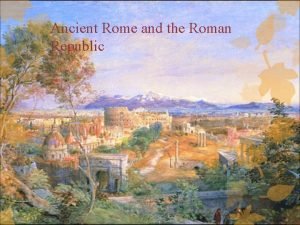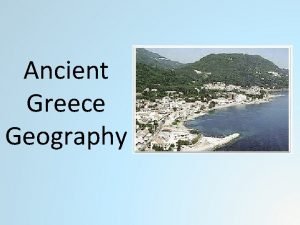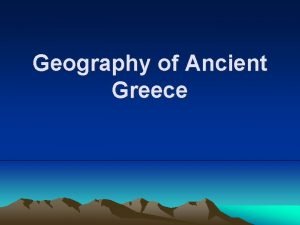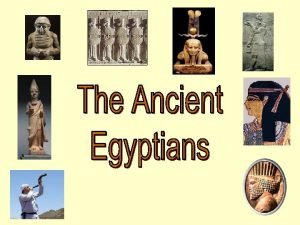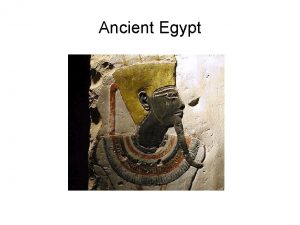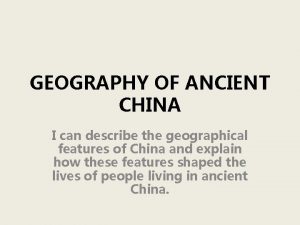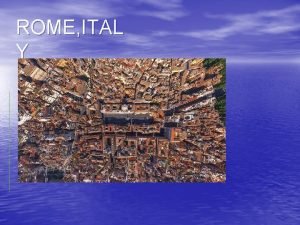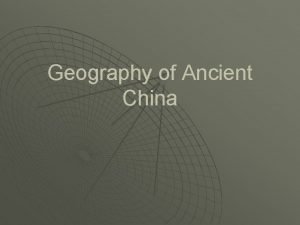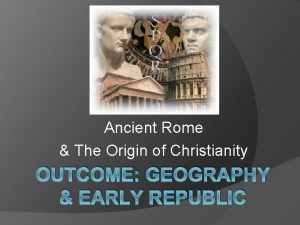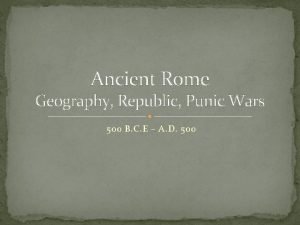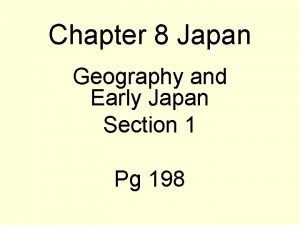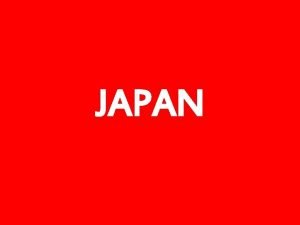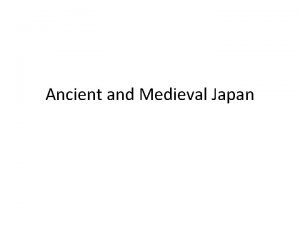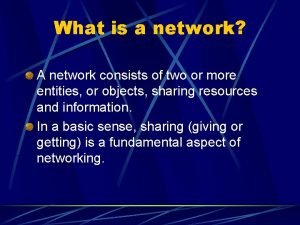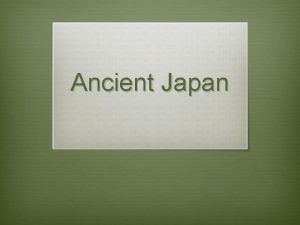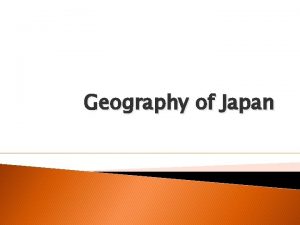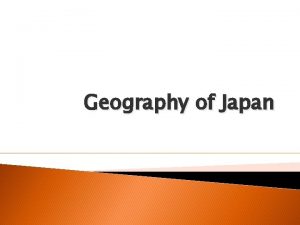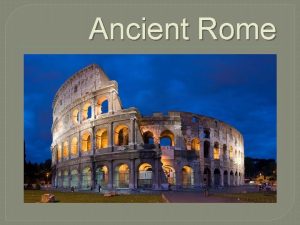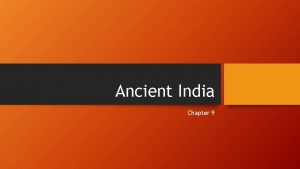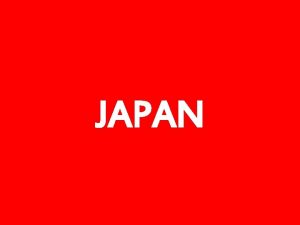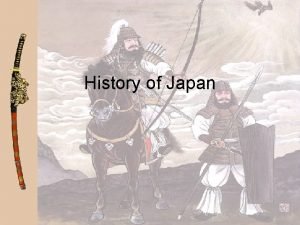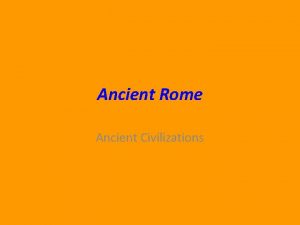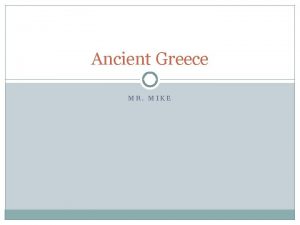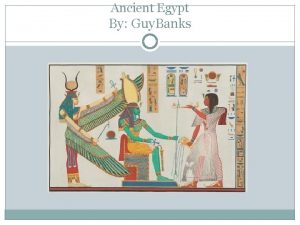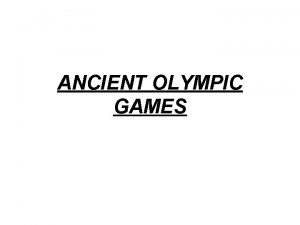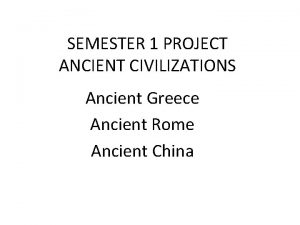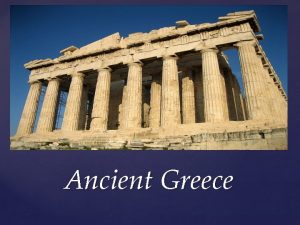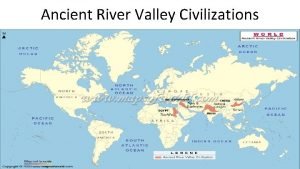Ancient Japan Japan Geography Japan consists of four
































- Slides: 32

Ancient Japan

Japan – Geography • Japan consists of four large islands and thousands of smaller ones • Kyushu (south) • Hokkaido (north) • Honshu (main) • Shikoku • Japan faces China & Korea to the west and the Pacific Ocean to the east • Japan is part of an archipelago • Japan has extreme climates • Snow in islands to the north • Tropics (almost) in islands to the south

Japan – Geography • Japan is a part of the Ring of Fire • Sits on a plate boundary • Volcanoes and earthquakes • Japan is mountainous • 20% is farmable • Most live on coast or few plains

Japan – Geography • • • First settlers likely came during the Ice Age (11, 000 years ago) • Land bridge – Korea (south) • Land bridge – Siberia (north) • Survived by hunting/fishing Another group arrived around 300 CE • New farming technique • - rice in irrigated fields Because of proximity – barrowed. . • China – writing system • Korea – Buddhism ********************

Japan – Religion Shinto • Native religion of Japan • Means “way of gods” • Each clan worshiped own kami (god/spirit) • Kami found in natural objects (trees) • People built shrines wherever felt the power of kami

Japan – Religion Shinto Myth (first emperor) • Sun Goddess and the Storm God (brother) • Each god supported a different clan who wanted to rule Japan • Sun Goddess won and her grandson Ninigi became ruler • She gave him three treasures: • • a bronze mirror (symbol of truth) • a sword (symbol of wisdom) • a curved jewel (symbol of kindness) Niningi passed symbols down to his grandson Jimmu who became first emperor in about 600 B. C.

Japan Religion Buddhism • Entered Japan in 552 from Korea • Many sects

Japan – Religion Pure Land Buddhism • Appealed to all classes • Most popular in Japan today • Centers around a bodhisattva known as Amida • • He ruled a paradise called Pure Land • Bodhisattva is enlightened being who choose to stay on earth and help others By placing trust in Amida and repeating his name, followers entered a paradise called Pure Land upon death

Japan – Religion Zen Buddhism • Came from China • Stressed meditation – clear mind to achieve spiritual development • Focus on self-control and discipline • Appealed to samurai class ******************

Japan Achievements The Tale of Genji • Considered to be the first novel in the world • It is about the romantic adventures of a prince named Genji • It was written by a woman named Murasaki Shikibu – she served the empress

Japan - Achievements v Yamato-e (scroll paintings) v Distinctly Japanese v Story is told as the scroll is unrolled v The story is told with pictures and sometimes words

Japan Achievements Noh drama • Serious and intense style of drama • Used colorful costumes, masks, chants, music, and dance Feature gods, warriors, beautiful women, mad people, ghosts, and devils • An evening of Noh drama would included several serious plays with funny skits in between •

Japan Achievements Kana • Around 900, Japanese simplified writing system • New set of symbols called kana • Each kana stood for one syllable ******************

Japan Politics First Emperor • Historians believe the first emperor appeared around A. D. 200 or 300 • Several clans competed/fought for land power • The Yamato clan gradually gained power over Japan

Japan Politics Yamato Clan • The Yamato clan gradually gained power over Japan • They would try to win another clans loyalty through marriage or warfare if necessary • They claimed to be descendants from the Sun Goddess • They believed they were living gods

Japan Politics Prince Shotoku • Took power in 593 • He was a regent – a person who governs in the name of a ruler (too young or unable to rule) • Goal was to unite Japan

Japan Politics Prince Shotoku • Goal was to unite Japan 1. 2. Bring Buddhism to Japan • Reduce power of clan leaders - people looked to clan leaders as Shinto priests • Having one faith would unite the country Bring Confucianism to Japan • Respect for family and social order • Prince Shotoku gave Japan it’s first constitution or plan of government • It was called the Constitution of Seventeen articles • Based on Buddhist and Confucian thought ******************

Japan Politics Reform • Prince Shotoku’s work carried on after his death in 622 • Taika Reform – means “great change” • Law that made everyone subject to the emperor • Lands and people controlled by the clans now belonged to the emperor

Japan Politics Reform • To carry out the reform, a new law code was issued to the entire country • Called the Taiho Code • Officially made the Yamato clan leader emperor • Included laws for the organization of local government • Defined crimes and punishments

Japan Politics Two New Capitals • Taika Reform also called for the building of a permanent capitol • The city of Nara was chosen and modeled after Chang’an in China • Buddha influence dominated the capital • Government officials felt threatened by wealth and power of Buddhist monks – moved the capital to Heian-kyo or Koyoto • Monks & monasteries were not allowed to follow

Japan Politics The Fujiwara Family • In the 800’s, the emperors power began to fade • Fujiwara family ran the country • The emperor was a “puppet” • Sisters or daughters would marry princes • Ruled for about 300 years & Japan was unified

Japan Politics The Shoguns • The Taira and Minamoto clans fought together and were able to drive the Fujiwara family from power • Over the years power shifted between the two clans

Japan Politics The Shoguns – Minamoto Yoritomo • In 1159, the Minamoto clan stormed the palace in Kyoto • In 1185, the two clans fought at sea • Minamoto Yoritomo was the winner and he took the title of Shogun – did not plan to give up the title • A new social order was developed **********************

Japan Economy Heian Period • Trade increased – economic growth • Towns sprang up • Along trade routes • As artisans created more goods for trading • Around monasteries • Artisans made goods and merchants bought and sold them • Trade increased with China • Exported • Swords • Pearls • Copper • Wood

Japan - Social What is feudalism? • Each daimyo relied on peasants to work the land. • In exchange for their labor, he provided protection. • The protection came in the form of samurai warriors • The daimyo would then give money or land to the samurai

Japan - Social v Emperor v Shogun v Daimyo v Samurai v Peasants/Merchants/Artisa ns A New Social Order • Life under Shoguns was lawless and violent • New social order developed

Japan - Social 1. Emperors (during Shoguns) • Had the highest rank, but held no real power

Japan - Social 2. Shoguns (during Shoguns) • Actual ruler of Japan • Highest military rank

Japan - Social 3. Daimyo (during Shoguns) • Large landowners who protected peasants in exchange for labor

Japan - Social 4. Samurai • Highly trained warriors • Trained fiercely, fought bravely, died with honor • Followed a code called the bushido • Bushido means “the way of the warrior”

Japan - Social 4. Samurai • • Personal Honor • Pride in how trained and fought • Pride in appearance (robe, armor, & horse) Loyalty to one’s lord • More important than family, religion, or emperor

Japan - Social 5. Peasants/Merchants/Artisans (during Shoguns) • Made up about three fourths of the population ************
 5 themes of geography japan
5 themes of geography japan 4 parts of great britain
4 parts of great britain Communication in ancient time
Communication in ancient time Ancient india vs ancient china
Ancient india vs ancient china Social classes in ancient japan
Social classes in ancient japan Ancient greece geography
Ancient greece geography The map of kush
The map of kush Geography of ancient rome
Geography of ancient rome Ancient greece geography
Ancient greece geography Balkan peninsula ancient greece map
Balkan peninsula ancient greece map Ancient egypt civilization geography
Ancient egypt civilization geography Disadvantages of ancient egypt geography
Disadvantages of ancient egypt geography Describe the geography of ancient greece
Describe the geography of ancient greece The geography of ancient china
The geography of ancient china Geography of ancient greece
Geography of ancient greece Ital roman
Ital roman Ancient china deserts
Ancient china deserts Ancient rome outcomes geography and early republic
Ancient rome outcomes geography and early republic Ancient rome geography
Ancient rome geography Japanese feudal hierarchy
Japanese feudal hierarchy Geography of japan
Geography of japan Japan physical geography
Japan physical geography Medieval japan geography
Medieval japan geography Ap human geography frq examples
Ap human geography frq examples 5 themes of geography ap human geography
5 themes of geography ap human geography Stateless nation
Stateless nation Heartland theory ap human geography
Heartland theory ap human geography Sonia deluanay
Sonia deluanay 4 eyes in 4 hours
4 eyes in 4 hours A slingshot consists of a light leather cup
A slingshot consists of a light leather cup Sliding into a slit sandwhich
Sliding into a slit sandwhich Network consists of
Network consists of 2 pipe drainage system
2 pipe drainage system
